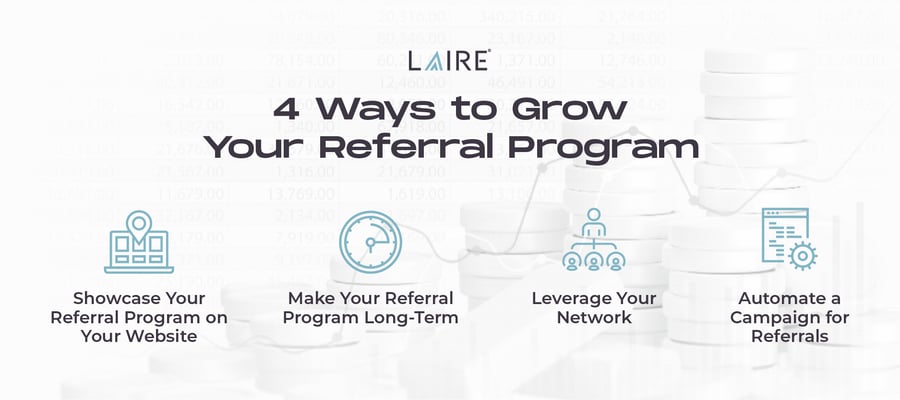The bulk of financial services have moved online, and traditional methods of finding and retaining investors or clients that will impact your bottom line are fading away.
Many in the financial services industry are considering ways to incorporate inbound marketing strategies to see reliable and sustainable revenue growth. Beyond that, leaders in the industry are noticing a need to pivot to differentiate their businesses from competitors.
A question we often encounter from our experience with clients in this space has to do with referral traffic. In a business environment that thrives on word-of-mouth and positive customer experience, it’s easy to question the long-term value that a digital strategy would bring. The point of a referral is a customer, right? We can all agree on that.
No matter the industry, a referral is considered a warm lead that you want to nurture in the right way to win their business at the right time. Let’s break down the key differentiators between inbound referrals and outbound referrals to help you make an educated decision about your next strategic move.
Understanding Inbound Referral Traffic for Financial Services
You may recall this familiar quote from the classic 1989 film, Field of Dreams: “If you build it, they will come.” The saying provides context for our brief lesson in inbound marketing.
Quite simply, inbound marketing allows your business and services to be found online by people who are already searching for something particular. They have a need that needs to be met, they are seeking help for that need, they do a quick search and find you — and voilà — the people come to you! That’s the hope anyway.
By attracting your audiences through valuable and engaging content tailored to their needs and pain points, you can ensure that these information-seekers will find you.
Inbound referrals are going to be your most qualified leads, with much higher conversion rates than outbound methods. The opportunity to be found online while someone is already searching for your expertise can establish trust and set you apart as a thought leader or expert to those who may have never heard of you otherwise.
Consider this example: A new doctor has recently graduated from medical school and is faced with the harsh reality of student loan debt welcoming him to his new career. Where does he start?
With a quick Google search for something like ‘financial planning for physicians’ or ‘medical student loan consulting’, the MD will be exposed to numerous options in Google just waiting to receive a click.
In this example, our client, Spaugh Dameron Tenny would be a perfect candidate for this physician’s business. They have sprinkled these keywords throughout their website and are writing supporting blog topics that establish credibility to earn the trust of this information-seeker.
There are two main ways that you’ll receive inbound referral traffic as a professional in the financial services space:
- Someone was looking for your services and found you organically (similar to the example above) and chose to willingly contact you
- Someone was convinced by a friend that they needed your services due to a positive experience they may have had with your firm.
The commonality in these two instances is trust. Either you’ve established trust by providing helpful, valuable information that answers their questions or speaks to their pain points — or you’ve earned the trust of one of your current clients who has so much faith in you and the experience you provided that they’ve decided to recommend you to a friend or family member.

Understanding Outbound Referral Traffic for Financial Services
Now, that we’ve unpacked inbound referral traffic, let’s look at the competing view on outbound referrals.
Think of outbound marketing as your traditional advertising methods. Some may even use the term “interruption marketing” in conjunction with outbound marketing methods. This outreach was unsolicited and unexpected.
Outbound referrals are only slightly better than an average lead but nowhere as warm or qualified as a referral won from an inbound marketing strategy. Whereas inbound referral traffic is more of an organic pull, outbound referrals are received through a weighty push. These individuals weren’t expecting to hear from you.
This method involves a large ask on your part, with a lot of your time and effort involved, and often hefty marketing spend behind it. At the start of an outbound lead conversation, there is little to no trust established between you and the prospect.
Can outbound methods work to capitalize on referral traffic and win the business of a lead? Absolutely! But understand that not all referrals are created equally.
Outbound referrals are not ineffective, you may just have a few extra steps involved to qualify the individual and understand how your financial services can help them.
How Do I Get an Inbound Referral?
How do you get people to refer your services to their friends and family?
A financial advisor asking for outbound referrals is not a bad thing. In other words, you can simply ask your clients to recommend you to their friends and family. Most people will not hesitate to do so as long as they’ve had a good experience.
However, an inbound referral program is a more effective and sometimes less hands-on method. It also can prove to be more rewarding. Creating a referral program means that you are giving your client — those who tell others about you — something for that transaction.
How to Create a Referral Program for Your Financial Services Business
Incentivized referral programs are often more likely to come to fruition. They also create better referrals. First, people are likely to refer an individual whom they think would most benefit from your services. They want the incentive you are offering, so they will tell those who are most likely to take action.
Additionally, individuals are more inclined to sign up for services if the company provides something for free or an extra incentive for immediate registration. A financial referral program is particularly effective as it not only motivates sign-ups but also encourages prompt action, especially when coupled with a time-limited offer (though not always necessary).
When you develop a referral program of some type, think about what the client is going to appreciate most. You may even want to ask some of your existing clients what would motivate or support their needs above and beyond what you do now.
There are many potential options for financial advisors. For example, some professionals offer a percentage off of their services. This can be a bit more expensive if you are using it on a large scale — just make sure it fits within your expectations and goals.
Other options can exist as well. For example, referrals may qualify for a free evaluation of their existing accounts or needs. Sometimes, if you often charge for an initial consultation, one of the best free perks to offer is that free consultation.
Think about other types of incentives, and make sure these are perks that will attract the type of client you are most likely to work with on an ongoing basis.
Tips for Boosting Your Financial Services Referral Program

Showcase Your Referral Program on Your Website
The only way referral marketing for financial advisors works is if you tell people about it. That seems simple enough, but it’s not always showcased well enough.
When you work with a team of marketing professionals, they can help you to create a solid landing page to help you to make your referral program clear.
Optimize landing pages that outline your referral program, and be sure to include all of the details that make this offer worthwhile. That is, be sure to tell the reader what the value of this service is in monetary figures but also in what it could mean to them. It needs to be clear that this is a valuable offer and one that is relevant to what they are looking for.
You want your audience to be able to see everything they need to learn about the referral program. They also need an easy way to act on it. Make it clear what they need to do to get the service you are offering. To make that easy to navigate, make sure there is a call to action (CTA) on the page.
This should include a full contact form that includes key information to ensure you can reach out to them and get an appointment set up. For example, it should allow the person to submit their name and contact information as well as the referring party’s name and email address so you can give them proper credit for the service.
Make Your Referral Program Long-Term
There are a lot of ways to customize a referral program to ensure it hits all of the right levels of interest for clients. Yet, one common mistake is creating a short-term referral program. This is often a sign that you need to boost revenue and do so only for a short time.
Sometimes, financial advisors and other professionals see referral programs as too expensive and limit how long they offer (or market) them because they want to reduce costs. This can cost you money in the long term.
Short programs do generate buzz and offer support for those who need it right now. The short-term increase in referrals is a good thing. However, the biggest problem with this is that not all of the people referred to your program are going to need your services right now. If you limit how long the referral is, you’re excluding people who may need to think about it for a bit.

A better option is to set up a referral program that you plan to keep in place for the long term. This way, you can reward financial advisor referrals for months to come or even longer.
An ongoing program enables people to sign up at any time they are ready, knowing that the service you are offering is available to them. It’s not uncommon for people to wait a year or more from hearing about the service to take action.
Leverage Your Network
The best referral sources for financial advisors are the people you’re already working with and helping now. Don’t be afraid to ask your existing clients to refer your services to their friends and family.
Don’t stop there, either. You can ask your friends and family for referrals, too. Many times, that huge network of people — friends of friends — can often provide an excellent level of access to potential new clients. It may even prove to be one of the best resources for helping you to build a stronger business.
How do you encourage people to support you? It’s easy. Ask your current clients about it when they come in to see you. You can even provide a document to help them.
It’s also important to ensure your social media is working to help you too. For example, you can ask an existing client to head to your social media page (or their own) and share their experience with your company. That creates a big stream of potential clients. Perhaps even take a photo with your clients that they can use to post on their social media to draw attention.
Create an Automated Campaign for Referrals
Referral marketing for financial advisors is a critical investment. That’s why you want to ensure you have numerous ways to connect. An automated campaign does this by sending emails to segmented lists asking for referrals. It often includes a nice surprise if they sign up — whatever you decide to offer.
Use this type of tool to ask current clients to leave you a review on Google for increased credibility and visibility to potential organic clients as well. You’ll find this is a simple way to boost your rankings there too.
Fueling Revenue Growth With Inbound Marketing for Financial Services
We understand that a referral is not the only way to grow your business. Inbound referral traffic is simply one component of a larger sales strategy and marketing plan that can seem extremely daunting to take on solo.
Your financial institution should be considering how to combat the disruptive fintech trends in the industry if you’re not already. The marketplace waits and slows for no one. More than likely, the winner of the search results race will also win the business.
LAIRE is a digital growth agency that understands the financial services industry, from commercial finance to private money lending, accounting, and bank marketing. We’ve got you and your clients covered.
Our team of experts is armed with the best tools to generate qualified leads through inbound marketing. Together we can close your warm inbound referrals into sustainable revenue for your business.

